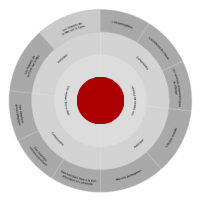Références
- World Health Organization. "Principaux repères : la résistance aux antibiotiques". Site web de l’Organisation Mondiale de la santé. 2020. Dernière consultation : le 25-07-2023.
- B. Houssni, H. Berkhli, H. Madani, A. Azzouzi. " Résistances bactériennes, consommation d'antibiotiques et politique de gestion de l'antibiothérapie", revue l'officinal N-88. 2011.
- Ministry of Health and Social Protection. National Coordination Unit and the Technical Committee for Antimicrobial Resistance Surveillance, Ministry official website. 2019. Last consulted: 25-07-2023.
- Le Fonds Mondial pour la Nature WWF. "Rapport Planète Vivante 2022 - Pour un bilan « nature » positif". 2022. p.4.
- Agence Nationale des Plantes Médicinales et Aromatiques. Vision stratégique de l’ANPMA (2018-2022), site web officiel de l’Agence. Dernière consultation : le 25-07-2023.
- Ministry attached to the Minister of Energy, Mines, Water and the Environment, in charge of the Environment. Morocco's National Strategy and Action Plan for Biological Diversity (2016-2020). 2020
- IPCC. "IPCC Special Report on the Ocean and Cryosphere in a Changing Climate" [H.-O. Pörtner, D.C. Roberts, V. Masson-Delmotte, P. Zhai, M. Tignor, E. Poloczanska, K. Mintenbeck, A. Alegría, M. Nicolai, A. Okem, J. Petzold, B. Rama, N.M. Weyer (eds.)]. Cambridge University Press, Cambridge, UK and New York, NY, USA: 2019. 755 pp.
- FAO. "The State of Food and Agriculture: Moving forward on food loss and waste reduction". Rome: 2019. Licence: CC BY-NC-SA 3.0 IGO.
- FAO. "The State of Food and Agriculture: Moving forward on food loss and waste reduction". Rome: 2019. Licence: CC BY-NC-SA 3.0 IGO.
- United Nations Environment Program. "Food Waste Index Report 2021". Nairobi.
- United Nations. “FAO warms 90 per cent of Earth’s topsoil at risk by 2050”. UN News. July 2022. Last consulted: 25-07-2023.
- United Nations. “FAO warms 90 per cent of Earth’s topsoil at risk by 2050”. UN News. July 2022. Dernière consultation : le 25-07-2023.
- FAO. "The state of the world’s land and water resources for food and agriculture – Systems at breaking point. Synthesis report". Rome : 2021. https://doi.org/10.4060/cb7654en.

